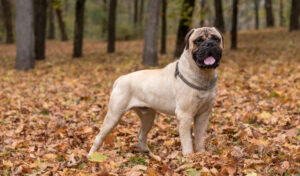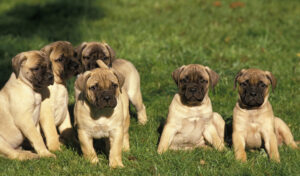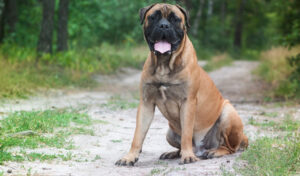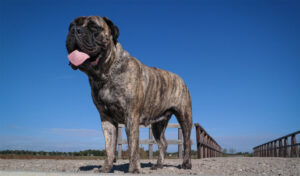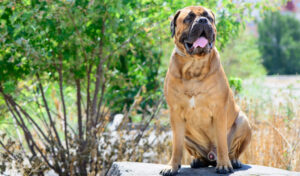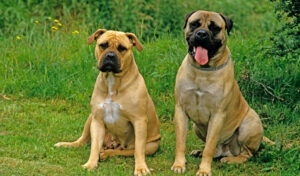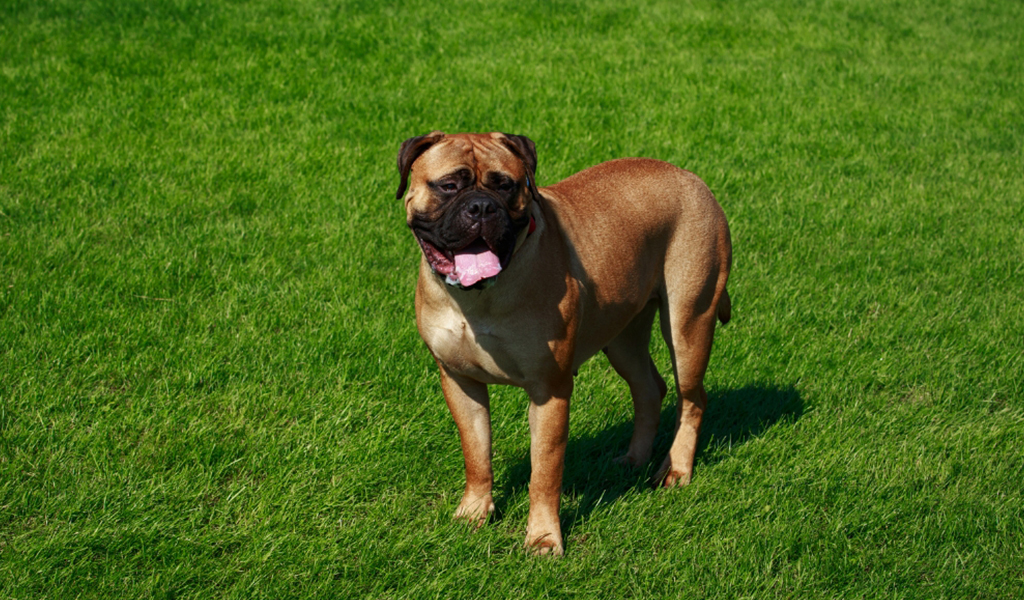What is a Bullmastiff Dog Breed?
The Bullmastiff is a large dog with a muscular physique and a short snout that resembles a British mastiff. Bullmastiff dog, a hybrid between the Old English Mastiff and the brave Bulldog, is the ideal manifestation of their characteristics and makes a devoted watchdog.
The bullmastiff dog is best suited to experienced pet owners who intend to keep them as the sole animal. Apartments can work as long as there is enough area for the dog to walk and run about every day. Houses with huge yards are great.
Content Overview
- History
- Different names
- Appearance and Characteristics
- Personality and Temperament
- Health & problems
- How to take care
- Puppy Information
- Puppy price
- Things to consider adopting a puppy
- Advantages & Disadvantages
- Photo gallery
Bullmastiff Dog History
The Bullmastiff-like dog breed originated in England in the mid-1800s. The Bullmastiff’s nickname, “The Gamekeeper’s Night Dog,” aptly describes the early stages of the breed. In the nineteenth century, it was created as a guard dog by mating the English Mastiff with the now-extinct Old English Bulldog.
Bulldogs at that time were considerably bolder and fiercer than now, although the breed was too immature to take down an adult. The Mastiff was too large and sluggish to work, the hybrid between the two breeds produced the perfect guard dog.
While the Bullmastiff still makes an excellent guard dog, it is today better known as a friendly companion and wonderful family dog. The breed was recognized by the American Kennel Club (AKC) in 1933.
Old English Bulldog History
The Old English Bulldog was approved as a unique breed in England for the bloodspots of bullbaiting. Depictions of vintage prints show that a small mastiff with a somewhat long head existed.
In the 1500 description of man, this species was first mentioned. Breeders in England began exhibiting bulldogs at conformation shows in 1859. Bulldogs were originally accepted for exhibition at a dog show in Birmingham, UK in the 1860s.
English Bulldogs were found in the United States. The English Bulldog was recognized by the American Kennel Club in 1890. They were among the top 10 breeds in terms of popularity in the 1940s and 1950s.
English Mastiff History
The Old English Mastiff, England’s classic large breed, has a long history. Mastiff dogs have been known around the world for thousands of years. There is still evidence of the fearsome giant beasts known as mastiffs in ancient Egypt, Greece, Rome, China and Tibet.
The mastiff’s ancestors probably came from the hills of Central Asia several thousand years ago. Roman words “massivus”, meaning huge, or “mastinus”, meaning house dog, are most likely where the word “mastiff” originates.
The molosser, which evolved mostly in the highlands of Asia in Tibet or northern India, is the ancestor of the mastiff, the oldest breed of dog.
Different Names or Types
Bullmastiff Dog Other Names
- Loyal
- Knight
- Legend
- Giant
- Jupiter
Recognized Names
Recognitions
- AKC: American Kennel Club
- UKC: Unite Kennel Club
- DRA: Dog Registry of America
- ACA: American Canine Association, Inc
- FCI: Fédération Cynologique Internationale
Appearance & Characteristics
The Bullmastiff is a handsome dog with an enormous, hulking head held high and an intense gaze. The body of the Bullmastiff dog breed is powerful and muscular, standing tall and majestically.
Its large chest, wide shoulders, and sloping back are supported by its sturdy, wide legs. It sways gently as its tapered tail whips at full speed and has a square, powerful build inherited from its Mastiff ancestry.
His forehead lines and the creases on the small, black stub of his muzzle are telltale signs of his bulldog heritage. His deep-set brown eyes are round and little sad-looking, and his jowls are slightly scowling.
The Bullmastiff often has a short, dense coat that is sleek and red or fawn in color with black highlights around the eyes.
Breed Basic Characteristics
- Country of Origin: United Kingdom
- Breed Group: Working Dogs
- Life Span: 08-12 Years
- Size: Extra Large
- Height: 24-27 Inch
- Weight: 100-130 Pound
- Coat: Short
- Type: Purebred
- Shedding: Seasonal
- Colors: Any Shade of brindle, Red, Fawn
- Also as known: Gamekeeper’s Night Dog
- Good with children: Yes
- Personality traits: Gentle, Friendly, Outgoing and Playful
- Good with pets: Yes
- Barking: Infrequent
- Competitive registration: AKC, UKC, FCI, DRA
- Eyes: Their eyes are black, medium in size.
- Ears: Their V-shaped, floppier ears are held close to their cheeks.
- Body: Strong Body
Coat
The coats of bullmastiff dogs are short and dense. Red, fawn brindle, and red brindle are just a few of the colors that their coats can be. On their chest, there could be a tiny white spot.
Color and Markings
Common coat colors for Crossbreed include.
- Fawn
- Fawn Brindle
- Red
- Red Brindle
- Red Fawn
- Red Fawn Brindle
Coat Color and Markings
Bullmastiffs have short, dense coats that provide good weather protection from rain, snow, and cold. The Bullmastiff could occasionally have a tiny white spot on their chest.
Personality and Temperament of Bullmastiff Dog
The Bullmastiff dog breed is a steadfast and fearless family guardian. Bullmastiffs are loving, jovial dogs that develop strong ties with their owners and make devoted companions.
The ideal Bullmastiff is bold and self-assured while still being submissive to their owners’ demands. They can think independently and are trustworthy, but they also have a desire to win people over.
They are a family’s natural protector, and if they feel endangered, they will act right away. Bullmastiffs rarely bark since they were raised to be silent watchdogs.
The Bullmastiff dog, a hybrid between the Old English Mastiff and the brave Bulldog, is the ideal manifestation of their characteristics and makes a devoted watchdog.
They were developed to locate, pursue, and capture predators. Bullmastiffs are not typically aggressive or vicious biters.
Activity Requirements
Bullmastiffs are naturally quite active, but light exercise should be encouraged. Bullmastiffs do not require hours of daily activity due to their average energy levels. This breed likes to run fast and play outside, but requires adequate fencing for outdoor spaces.
Daily walks and spend time with the children in a fenced yard to prevent obesity and boredom and improve the bond. Puppies should not be overworked, especially when they are growing rapidly.
Bullmastiffs make excellent walking companions but are not the best breed for those looking for a canine running partner. These dogs are moderately sensitive to heat, if it’s really hot outside, schedule the outdoor activities when it’s cooler.
Trainability
Bullmastiffs and other large breeds need a knowledgeable pet owner who is prepared to devote time to socializing and teaching them. These dogs are intelligent and quick learners, so they pick up basic commands like sit, stay and come and tricks instantly.
Space is a great command to teach the Bullmastiff not to be attached to guests coming into the home. Exercise should be carefully monitored until the bullmastiff is at least 12 months old. Jumping and stair climbing while exercising excessively young can cause bone and joint issues later in life.
They enjoy playing games and exercising the dog with the family. The Bullmastiff adult will remain happy with an hour of exercise each day and the freedom to laze around in the garden.
Health & Problems
Bullmastiffs are generally healthy dogs, but like all breeds, they can be subject to certain health conditions. When considering the Bullmastiff breed it is important to be aware of their health.
This breed has a variety of health issues, including cancer, hip and elbow dysplasia, torn ACLs, bloat, subaortic stenosis, skin and coat issues, hypothyroidism, and entropion.
Hip Dysplasia: The thigh bone does not fit snugly into the hip joint due to this hereditary disease. Dogs with hip dysplasia may not show any signs of discomfort, but they may have pain and lameness in one or both of their rear legs.
Elbow Dysplasia: This hereditary condition is typical for large breed dogs. The three bones that make up a dog’s elbow are thought to grow at different rates, resulting in joint laxity, which is believed to be the root of the problem.
Subaortic Stenosis: The aorta narrows below the aortic valve, causing the heart to work harder to pump blood throughout the body. This frequent cardiac defect results from this. This ailment may result in dizziness and possibly abrupt death.
Cancer: Dogs like bullmastiffs can develop cancer much like people. Cancer comes in a wide variety of forms, and each patient’s response to treatment is unique.
Feeding Plan
The nutritious, well-balanced diet will be beneficial to bullmastiffs. Follow feeding guidelines on commercial dog food to avoid overfeeding the dog. The veterinarian can advise you on the proper feeding schedule for you Bullmastiff based on its age, health, and way of life.
Most bullmastiff breeders recommend feeding adult dog food or large breed puppy food to puppies to ensure slow and consistent growth. Large breed puppy-specific brands include Hill’s, Purina, and Royal Canin.
Bullmastiffs that are between one and two months old are prescribed 3 to 4 cups of food per day. 3-4 meals per day should contain 1 cup of food. A 2-3 month old Bullmastiff should eat 4 to 6 cups of food per day.
A 3-4 month old Bullmastiff should eat 5-7 cups of food per day. A 4-6 month old bullmastiff should be fed 6 to 8 cups per day as recommended. 8 to 12 cups of food per day is recommended for bullmastiffs 6 to 18 months of age.
Living Conditions
The average lifespan of a bullmastiff is about 8 to 12 Years. The Bullmastiff is a strong and noble dog that requires a caring owner who can devote a lot of time to them. Bullmastiffs are not high-energy dogs, but they do need some exercise.
They have a peaceful disposition and are calmer than other kinds. While the dog is often calm and friendly, supervision is necessary when the dog is around young people as the dog is large enough to accidentally knock over a child.
Training and socialization are essential for a good coexistence with this breed. The dog can learn to be less wary of strangers and guests by being exposed to as many new people, places, and circumstances as you can, especially while he is a puppy.
How to Take Care of Bullmastiff Dog?
The Bullmastiff is a low-energy dog that can fit in well in most home settings. Due to their large size they are best suited for homes with fenced yards. Bullmastiffs are prone to heat exhaustion and heatstroke because of their short muzzles.
Keep children inside if it’s hot or humid outside and avoid exercising during the hottest part of the day. As soon as you bring a Bullmastiff puppy home, you should begin training it.
It is important to give them proper food on time. It is very important to take care of their health. Training plays an important part for them.
Grooming & Brushing
They have more coats to shed than larger bullmastiffs. Maintain their coat condition and minimize the effects of shedding by using a bristle brush, grooming glove or rubber brush.
Schedule a weekly brushing for the dog. Throughout the spring and fall, brushing is necessary several times a week.
Take time and clean their ears. Cleaning their ears is important because it helps protect them from infections, ear mites and allergies.
Depending on how dirty the dog gets, a bullmastiff may only need to be bathed once a month. A cotton ball soaked in warm water can be used to clean the area around the eyes. Every month, they should cut their nails.
Also Read: Cavachon Dog Breed
Feed Healthy food
Bullmastiff dogs, like all dogs, need a total of 5 nutrients: protein, fat, vitamins, minerals, carbohydrates with protein and fat are especially important because they make up the bulk of their diet.
The stomach of a dog is not physically suited for the fermentation and digestion of carbohydrates. Even kibble made without grains frequently include a lot of starchy vegetables like beans, peas, and lentils.
Bullmastiffs need a healthy balance of nutrients to thrive. The recommended daily calorie composition for puppies is 12-15% fat and 25-27% protein. Bullmastiffs as adults can live on a diet of 18–25% protein and 10% fat.
Their diet consists of vegetables that are abundant in vital vitamins and minerals, ground bones, and proteins that are biologically appropriate, as well as healthy fats.
The following items Should never be feed to Labradoodle Dog
- Grapes or raisins
- Moldy or spoiled food of any kind
- Yeast dough
- Chocolate, coffee, or tea
- Poultry bones
- Tomato leaves stem or unripe fruit
- Alcohol, beer, wine or liquor
- Salt & salty foods
- Onions, chives, and garlic
Puppy Information
Bullmastiff Dog Puppy Training
The bullmastiff dog should be trained as soon as you bring it home. Their puppies require training in manners, obedience, and socialization. All of these training methods are used to teach a baby bullmastiff how to get along with every member of the family.
Behavioral Training
Training in appropriate behavior is crucial for bullmastiff dogs. This advice on caring for dogs is really helpful. If you wish to teach the puppy good behavior, you should first identify some typical behavioural issues including barking, antagonism, food security, crying, mouthing and chewing, separation anxiety, etc.
Obedience Training
Obedience training plays a very important part for bullmastiff dogs. Teaching children how to act around dogs is important. Bullmastiffs are not difficult to train due to their high intelligence, dedication and desire to please.
The secret to teaching one of these critters is to be persistent and patient. Simple commands like “sit,” “stay,” and “down” are a good place to start.
Socialization
Every dog has to be socialized. Avoid meeting folks at the dog park. Constantly switch up good routines. Attending meet-and-greets while being on a leash will allow an adult Bullmastiff to start interacting with friendly, well-behaved dogs.
Both puppy lessons and obedience programmes are fantastic options for socialization. Let them to become accustomed to and conscious of their environment.
Bullmastiff Dog Puppies for Sale
The Bullmastiff is one of the gentle giants of the dog world and is tall, proud, and courageous. They are ideal family companions since they are self-assured, trustworthy, and fiercely protective of their family.
The average cost of a Bullmastiff puppy from a respectable breeder is between $1,500 and $2,500, but the highest-quality puppies can cost upwards of $3,500.
Things to Consider Adopting a Bullmastiff Dog
- Bullmastiffs are intelligent, devoted, and protective dogs who enjoy pleasing their owners in addition to drooling and snorting.
- The relatively calm existence of the Bullmastiff might just be for you if you reside in a densely populated apartment complex or simply prefer some solitude occasionally.
- Most people find the Bullmastiff threatening, yet he’s actually recognized for being peaceful and never boisterous.
- The two-legged members of the family will get along wonderfully with the bullmastiff, but the four-legged members won’t get along so well.
- The Bullmastiff is a low energy dog with a nearly insatiable appetite, he’s more likely to develop obesity than some other breeds.
Advantages and Disadvantage
Advantages of Bullmastiff Dog
- They are simple to groom.
- They don’t require one more workout.
- The bullmastiff is known for being a good guard dog.
Disadvantages of Bullmastiff Dog
- They have a tendency to commit violence against other animals.
- They can be stubborn so they can be difficult to train.
- The bullmastiff dog has a greater tendency to bark than other breeds.
Bullmastiff Dog Photo Gallery
